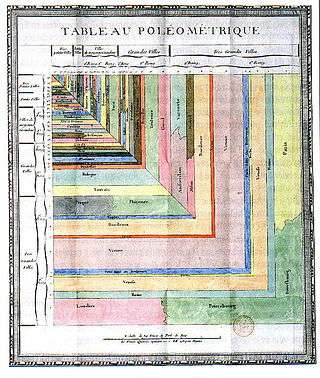Charles Louis de Fourcroy
Charles Louis de Fourcroy (1766–1824[1]) was a French mathematician, scholar and director of fortifications, known from his 1782 treatise, entitled "Essai d’une table poléométrique"[2]
Biography
De Fourcroy was born in the French countryside. He is the author of Essai d'une table poléométrique, a treatise on engineering and civil construction, published in 1782, which is remarkable for its period in its use of graphs to list the achievements of civil engineers of bridges and roads from 1740 to 1780 and its cross-sectional and mathematical analysis of the growth of urban areas.
He was awarded the title Chevalier de la Légion d'honneur by Napoleon and the Arch Chancellor of France, the Prince in 1810, while Consul in Cologne. He was also awarded a crest with three argent crescents upon a blue background, intersected by a golden peak above the symbol of the Légion d'honneur on a gules background.
The Harrow School Archives have the grant of arms to the Chevalier, Charles de Fourcroy, signed by Napoleon.
Work
Essai d’une table poléométrique, 1782
In 1782 De Fourcroy published his "Essai d'une Table Poléométrique, ou amusement d'un Amateur de Plans fur les grandeurs de quelques Villes; Avec une carte, ou Tableau qui offre la comparaison de ces Villes par un même échelle." This book gives an analysis of the urban growth of European cities, which are graphically compared in a diagram, called Table Poléométrique or Poleometric Table.

In his work De Fourcroy (1782) explained:
- "If we have the surfaces (i.e., areas) of all the cities/villages in the table, or the proportions representing these cities, transformed into cross-sections, each of equal extension, and each on the same scale; then if we successively put one on the other, from the largest to the smallest, and joined all by one of their angles; these squares would overlap relative to their size, and the whole would form a kind of table that visually represents an idea of the actual proportion that can be found between the surfaces of these different cities. We could as well find in this table two cities of equal size, cut their squares diagonally, and have the table represent only half of each; which essentially means the same. Such is the attached figure, which requires no further explanation."[3]
A 1782 review of this work by Élie Catherine Fréron mentioned, that the Table Poléométrique explained in the work is plausible for at least 230 cities, foreign and domestic.[4] More recently Jacques Bertin in his Semiology of Graphics (1983) further explained the work, which was first published anonymously. In the French National library the work is still listed by its publisher.[5] Bertin wrote
- "The 'Poleometric Table' (see figure), published in 1782 by Dupain-Triel, is one of the oldest proportional representations of human phenomena which is currently known. François de Dainville has demonstrated... that the author was Charles de Fourcroy, a Director of Fortification.
- [in the diagram] each city is represented by a square whose area is proportional to the geographic area occupied by the city (and for the smallest cities, by a half square only, divided by the diagonal line.
- When superimposed, the squares are classed automatically. This results in visual groupings which lead the author to propose an 'urban classification.' This example allows us to appreciate the evolution of graphic representation and the efficiency of more recent solutions, based on the standard construction."[6]
De Fourcroy's map is similar to the comparison diagram the German economist and statistician August Friedrich Wilhelm Crome published in 1785, entitled "Groessen Karte von Europa." This map made a comparison of European states, instead of a comparison of cities in the Poleometric Table. Palsky (1996) concluded, that "the Table established by Fourcroy signals a fundamental moment in the evolution of the graphical method. We see the passage to the abstract, to fictitious features. By these proportional triangles, the author constructs an image that does not return/relate to its original existence."[7]
Selected publications
- de Fourcroy, Charles. Essai d’une table poléométrique, ou amusement d’un amateur de plans sur la grandeur de quelques villes. Dupain-Triel, Paris (1782).
- de Fourcroy, Charles-Louis. Coup d'œil sur la Galice. 1807.
References
- ↑ Paulo Nogueira Santiago (ed.) Ollada sobre a Galiza de 1807 de Charles-Louis de Fourcroy (1770-1824), Toxosoutos (Colección Anais), 2008.
- ↑ Friendly, Michael, and Daniel J. Denis. "Milestones in the history of thematic cartography, statistical graphics, and data visualization." Seeing Science: Today American Association for the Advancement of Science (2008).
- ↑ De Fourcroy (1782), cited in: Gilles Palsky (1996): Des Chiffres et des Cartes, p.51-52; Translated by Daniel J. Denis. "Des Cartes Generates Aux Cartes Spectates" at euclid.psych.yorku.ca, April 7, 2002.
- ↑ Élie Catherine Fréron (1782) L'année littéraire ou Suite des lettres sur quelques écrits de ce temps, Vol. 5-6. p. 71
- ↑ See also: worldcat.org, and google books accessed 14.01.2015.
- ↑ Jacques Bertin. Semiology of Graphics, 1983. p. 203
- ↑ Gilles Palsky (1996): Des Chiffres et des Cartes, p.51-52; Translated by Daniel J. Denis. "Des Cartes Generates Aux Cartes Spectates" at euclid.psych.yorku.ca, April 7, 2002.